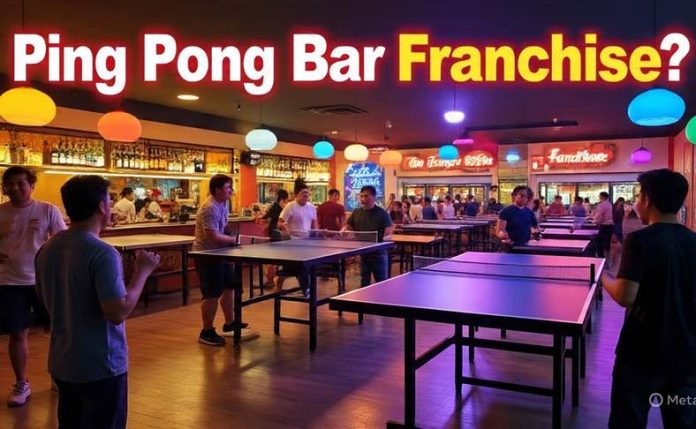
Alright, let’s talk about something a little out of the box, shall we? You’ve probably seen your fair share of coffee shop franchises, fast-food joints, and even gym franchises popping up across Metro Manila. But what about a ping pong bar franchise? Yes, you read that right – a place where you can grab a drink, some good food, and challenge your friends to a few rounds of table tennis. Sounds intriguing, doesn’t it? As someone who’s spent nearly a decade diving deep into the Philippine franchise landscape, I’ve seen all sorts of concepts come and go, and trust me, the ones that truly shine are those that offer something more than just a product – they offer an experience.
Is a ping pong bar franchise a smart move for the Philippine market? From where I’m standing in Makati, with the vibrant energy of Filipino consumers all around, I’d say it absolutely holds promise, provided you approach it with the right strategy. We’re living in an evolving “experience economy” where people aren’t just looking to buy things; they’re looking for memorable moments, opportunities to connect, and novel ways to unwind. Think about the rise of escape rooms, board game cafes, and even niche hobby centers – Filipinos love to gather, to compete, and to have a good laugh. I remember back in my early days covering franchises, everyone was obsessed with the next big food craze. Now, it’s about what you do while you’re eating or drinking. A ping pong bar fits right into this evolving demand for interactive, social entertainment. Filipinos have a natural affinity for games and a fantastic sense of camaraderie, which makes a social activity like table tennis a natural fit for our culture of fun and friendly competition. It’s not just about the game; it’s about the laughter, the cheering, and the stories created around the table. For more on the experience economy’s impact on consumption, you can refer to insights from the Consultative Group for International Agricultural Research (CGIAR).
What Makes a Ping Pong Bar Franchise Tick? Lessons from Bounce in the UK
When we talk about a successful ping pong bar franchise, the conversation often turns to pioneers like Bounce in the UK. I’ve followed their journey from afar, and what they’ve built is far more than just a room with ping pong tables. Their concept, is about fusing high-quality food and beverage with engaging social ping pong, all set in a stylish, vibrant atmosphere. They’ve perfected the art of the “social playground,” where the game is the centerpiece, but the entire experience – from the curated music to the innovative cocktails and delicious bites – is meticulously crafted.
Watch this video to get a glimpse:
Bounce didn’t just throw some tables in a bar; they designed a cohesive entertainment hub. They offer different types of play, from casual bounces to competitive tournaments, and they’ve embraced technology to enhance the experience, like automated scoring. Their success lies in understanding that while ping pong is the hook, the environment, the service, and the overall vibe are what keep people coming back. Can this UK success story translate to Manila? Absolutely. The core elements – social interaction, engaging activity, and quality F&B – are universal. The challenge, and opportunity, for a ping pong bar franchise in the Philippines would be to localize that appeal, perhaps by integrating Filipino food favorites or tailoring the music to local tastes, while maintaining the high standards of a globally successful brand. Think about how karaoke bars here thrive – it’s about shared fun, and table tennis has that same potent social ingredient.
The Pros and Cons of Serving Up a Ping Pong Franchise in the Philippines
Every business venture has its bright spots and its tricky corners, and a ping pong bar franchise is no different. Weighing these carefully is crucial before you dive in.
Pros: Why a Ping Pong Bar Could Win Big Here
- Novelty and “Instagrammability”: Filipinos love new experiences, and a ping pong bar offers a fresh, unique concept that stands out from typical bars or restaurants. It’s inherently “Instagrammable,” which means free marketing for your business as patrons share their fun online. This aligns with broader Philippine entertainment industry trends towards diverse and engaging leisure activities.
- Broad Appeal: Ping pong isn’t just for sports fanatics. It’s a casual, low-impact game that appeals to a wide demographic – from friends looking for a unique night out to corporate teams seeking team-building activities, and even families (during daytime hours, perhaps).
- Multiple Revenue Streams: Beyond table rentals, you’re looking at significant income from food and beverages, event bookings (birthdays, corporate functions), merchandise, and potentially even professional coaching sessions. This diversification buffers against reliance on a single income source.
- Community Building: A well-run ping pong bar can become a community hub, fostering friendly rivalries and regular patronage. This creates a loyal customer base, essential for long-term success.
- Lower Barrier to Entry for Casual Play: Unlike bowling or billiards, which can sometimes feel intimidating to beginners, ping pong is often perceived as more accessible and less serious, encouraging broader participation.
Cons: The Challenges You’ll Need to Paddle Through
- Space Requirements: Ping pong tables, even smaller ones, take up significant floor space. Finding a prime location in dense urban areas like Metro Manila that’s both affordable and spacious enough can be a challenge. You need ample room for tables, walkways, and comfortable seating areas.
- Initial Investment: While potentially lucrative, setting up a proper ping pong bar with quality tables, sound systems, kitchen equipment, and a well-designed interior can require a substantial initial capital outlay. This is where thorough financial planning comes in.
- Educating the Market: While ping pong is known, the concept of a bar centered around it might be new to some. You’ll need effective marketing to explain the concept and draw in the crowds, distinguishing yourself from a simple sports bar. Leading entertainment publications like YES! Magazine could be valuable partners in this regard.
- Maintenance and Wear-and-Tear: Ping pong tables and equipment will see heavy use. Regular maintenance, repair, and replacement of paddles and balls will be ongoing costs.
- Competition for Leisure Spend: Filipinos have many options for their leisure budget. Your ping pong bar needs to offer compelling value and a consistently great experience to compete with malls, cinemas, and other entertainment venues.
Think about it: the unique experience you offer could be your greatest differentiator. What unexpected twist can you add to make your ping pong bar unforgettable? Perhaps themed nights or local DJ collaborations?
Pros and Cons of a Ping Pong Bar Franchise in the Philippines
Navigating the Franchise Maze: Key Considerations Before You Serve
So, you’re warming up to the idea of a ping pong bar franchise? Excellent! Now, let’s get down to the nitty-gritty of making it a reality. From my years of experience advising aspiring franchisees, these are the pivotal areas you absolutely need to nail down.
Location, Location, Location: Finding Your Sweet Spot
Choosing the right spot is like picking the perfect serve – it can set you up for a winning point. For a ping pong bar, you need visibility, accessibility, and sufficient space.
- Visibility: Being easily seen by passersby, especially during evening hours, is crucial. Malls, entertainment complexes, or high-traffic commercial areas are strong contenders.
- Accessibility: Is it easy for your target demographic to get to, whether by public transport or private vehicle? Ample parking is a huge plus in Manila.
- Space: As mentioned, you need generous floor area for multiple tables, allowing comfortable play and circulation. Don’t underestimate the need for waiting areas, bar space, and restrooms. Consider areas near universities or corporate offices – prime targets for both casual and after-work crowds.
Beyond the Paddle: Food, Beverage, and Event Strategies
Your success won’t just hinge on the ping pong. Your food and beverage program needs to be on point.
- Curated Menu: Don’t just offer standard bar fare. Think about easy-to-eat, shareable items that don’t require too much fuss while playing. High-quality craft beers, inventive cocktails, and even some unique mocktails can significantly boost your average spend per customer.
- Event Hosting: This is a goldmine. Actively market your space for corporate team-building events, birthday parties, product launches, and even small tournaments. Offering customizable packages with F&B and table time can fill your calendar and secure large bookings.
- Music and Vibe: The ambiance is key. A lively, upbeat playlist that encourages fun without being overpowering is essential. Consider occasional live DJ sets to elevate the energy on weekends.
Marketing Your Way to a Full House: Reaching the Filipino Crowd
Filipinos are social media savvy, so your marketing needs to be too.
- Digital Presence: A strong online presence is non-negotiable. Invest in engaging social media content (Facebook, Instagram, TikTok) showcasing the fun, the food, and the overall vibe. Run targeted ads.
- Influencer Marketing: Collaborate with local influencers or content creators who align with your target audience. They can showcase the experience authentically.
- Partnerships: Forge alliances with local businesses, sports clubs, or corporate entities for cross-promotions or exclusive event packages. Think about tying up with local esports communities; while different, they appreciate the competitive and social aspects of gaming.
Remember: While the game draws them in, the overall experience makes them regulars. What unique Filipino touches can you weave into your concept to make it truly local and beloved?
Show Me the Money: Financials and ROI for a Ping Pong Bar Franchise
Let’s talk numbers, because at the end of the day, a franchise needs to make financial sense. Investing in a ping pong bar franchise requires a clear understanding of your initial outlay and potential returns.
Initial Investment: What to Budget For
The exact figures will depend heavily on the franchisor, the size of your chosen location, and the level of fit-out required. However, you should generally prepare for:
- Franchise Fee: This is the upfront cost to buy into the brand and gain access to their systems, training, and ongoing support.
- Leasehold Improvements/Renovations: This will likely be your biggest chunk of investment. Think about the construction, interior design, lighting, soundproofing (if needed), and the overall aesthetic.
- Equipment: High-quality ping pong tables, nets, paddles, balls, scoring systems, and any specialized lighting for the tables. Plus, a fully equipped kitchen and bar.
- Inventory: Initial stock of food, beverages, and any merchandise.
- Pre-Operating Expenses: Permits, licenses, marketing launch, staff training, and initial working capital.
A ballpark figure for a mid-sized entertainment franchise in a prime Metro Manila location could easily range from PHP 8 million to PHP 20 million or more, depending on the scale and brand. It’s crucial to get a detailed financial disclosure document from any franchisor you consider. For more general insights into the franchise landscape in the Philippines, consult resources like Franchising Ph.
Estimated Initial Investment Breakdown for a Mid-Sized Ping Pong Bar Franchise (Metro Manila)
Projected Revenue Streams: More Than Just Table Fees
The beauty of a ping pong bar is its diverse income sources:
- Table Rental Fees: This is your core, charged hourly or per game.
- Food and Beverage Sales: Often the largest revenue contributor, especially if your menu is enticing.
- Event Bookings: Corporate events, private parties, and tournaments can provide significant lump sums.
- Merchandise Sales: Branded apparel, paddles, or unique ping pong accessories.
- Membership Fees: For frequent players or competitive leagues.
Breaking Even and Beyond: Realistic Timelines
Achieving profitability depends on many factors: your location, marketing effectiveness, operational efficiency, and customer traffic. Generally, entertainment and F&B franchises can take anywhere from 1.5 to 3 years to reach break-even point and start generating substantial profits. A strong marketing push in the initial months, combined with excellent customer service, can significantly accelerate this. Always model your cash flow carefully and have sufficient working capital to sustain operations during the ramp-up phase.
My tip: Don’t just focus on the top-line revenue. Keep a hawk’s eye on your cost of goods sold and operational expenses. Efficient inventory management and smart staffing can make all the difference in your bottom line.
FAQs: Your Top Questions About a Ping Pong Bar Franchise Answered
Here are some common questions I hear about this unique franchise concept:
- What kind of space do I need for a ping pong bar? You’ll need a sizable open space, typically at least 150-300 square meters (or more) to comfortably fit multiple tables, a bar area, kitchen, and seating. Each table ideally requires about 4.5m x 8.5m of clear playing space, including room for players to move.
- Is ping pong popular enough in the Philippines to sustain a bar? While perhaps not as mainstream as basketball, ping pong has a strong, passionate following in the Philippines, from casual players to competitive leagues. The key is to market it as a fun, social experience that anyone can enjoy, not just serious players.
- What are the typical operating costs for a franchise like this? Beyond initial investment, recurring costs include rent, utilities, staff salaries, food and beverage supplies, ongoing marketing, maintenance for tables and equipment, and royalty fees to the franchisor.
- How do I attract both serious players and casual customers? Offer dedicated “league nights” or tournaments for serious players, while promoting “fun nights” with music, themed drinks, and introductory games for casual groups. Varied pricing models for different times can also help.
- What kind of support can I expect from a ping pong bar franchisor? A good franchisor will provide comprehensive support, including site selection assistance, training programs (for you and your staff), marketing materials, operational manuals, supply chain guidance, and ongoing business consulting. Their experience is invaluable.
Serving Up Your Next Big Idea: Is a Ping Pong Bar Franchise Your Ace?
So, after all this talk, are you ready to serve up your next big idea with a ping pong bar franchise? The Philippine market is ripe for innovative entertainment concepts, and a ping pong bar offers a compelling blend of social activity, competitive fun, and solid F&B opportunities. While challenges exist, particularly around space and initial investment, the potential for high returns and a truly unique business cannot be ignored. If you have a passion for creating engaging experiences and a keen eye for operational excellence, a ping pong bar franchise could indeed be your ace in the hole, transforming a simple game into a thriving social hub. It’s a venture that promises not just profit, but also the satisfaction of bringing people together for pure, unadulterated fun. Before making a final decision, you might also want to read about Understanding Franchise Agreements in the Philippines to be fully prepared.
{
“@context”: “https://schema.org”,
“@graph”: [
{
“@type”: “BlogPosting”,
“mainEntityOfPage”: {
“@type”: “WebPage”,
“@id”: “https://franchisemanila.com/2025/07/is-a-ping-pong-bar-franchise-a-good-idea-for-the-philippines/”
},
“headline”: “Is a Ping Pong Bar Franchise a Good Idea for the Philippines?”,
“description”: “Considering a ping pong bar franchise in the Philippines? Explore if this unique entertainment concept, inspired by UK success stories like Bounce Ping Pong, is a smart investment in Manila’s thriving experience economy. Get expert insights on pros, cons, costs, and key strategies for success from FranchiseManila.com.”,
“image”: {
“@type”: “ImageObject”,
“url”: “https://franchisemanila.com/wp-content/uploads/2025/07/ping-pong-bar-featured-image.jpg”
},
“author”: {
“@type”: “Person”,
“name”: “Jhona Yellin”
},
“publisher”: {
“@type”: “Organization”,
“name”: “Franchise Manila”,
“logo”: {
“@type”: “ImageObject”,
“url”: “https://franchisemanila.com/wp-content/uploads/2025/07/franchise-manila-logo.png”
}
},
“datePublished”: “2025-07-22T11:01:35+08:00”,
“dateModified”: “2025-07-22T11:01:35+08:00”
},
{
“@context”: “https://schema.org”,
“@type”: “FAQPage”,
“mainEntity”: [
{
“@type”: “Question”,
“name”: “What kind of space do I need for a ping pong bar?”,
“acceptedAnswer”: {
“@type”: “Answer”,
“text”: “You’ll need a sizable open space, typically at least 150-300 square meters (or more) to comfortably fit multiple tables, a bar area, kitchen, and seating. Each table ideally requires about 4.5m x 8.5m of clear playing space, including room for players to move.”
}
},
{
“@type”: “Question”,
“name”: “Is ping pong popular enough in the Philippines to sustain a bar?”,
“acceptedAnswer”: {
“@type”: “Answer”,
“text”: “While perhaps not as mainstream as basketball, ping pong has a strong, passionate following in the Philippines, from casual players to competitive leagues. The key is to market it as a fun, social experience that *anyone* can enjoy, not just serious players.”
}
},
{
“@type”: “Question”,
“name”: “What are the typical operating costs for a franchise like this?”,
“acceptedAnswer”: {
“@type”: “Answer”,
“text”: “Beyond initial investment, recurring costs include rent, utilities, staff salaries, food and beverage supplies, ongoing marketing, maintenance for tables and equipment, and royalty fees to the franchisor.”
}
},
{
“@type”: “Question”,
“name”: “How do I attract both serious players and casual customers?”,
“acceptedAnswer”: {
“@type”: “Answer”,
“text”: “Offer dedicated \”league nights\” or tournaments for serious players, while promoting \”fun nights\” with music, themed drinks, and introductory games for casual groups. Varied pricing models for different times can also help.”
}
},
{
“@type”: “Question”,
“name”: “What kind of support can I expect from a ping pong bar franchisor?”,
“acceptedAnswer”: {
“@type”: “Answer”,
“text”: “A good franchisor will provide comprehensive support, including site selection assistance, training programs (for you and your staff), marketing materials, operational manuals, supply chain guidance, and ongoing business consulting. Their experience is invaluable.”
}
}
]
}
]
}

Jhona has been active in the Real Estate Market in the Philippines for the last 17 years. She’s a real estate Consultant, Property Manager, and Broker dealing with various developers all across the country.




